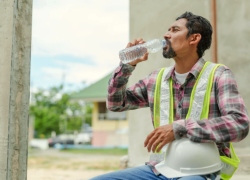
When we think of Black Americans’ fight for equality, we often focus on the fight for voting rights and equal access to education and public accommodations. Often forgotten is how deeply intertwined the fight for civil rights and the fight for economic rights has been for Black Americans. The history-changing event we know as the March on Washington, where Dr. Martin Luther King Jr. gave his “I Have a Dream” speech, was actually called “The March on Washington for Jobs and Freedom,” and was organized through an alliance of labor, civil rights and religious organizations. The leaders of the Civil Rights Movement clearly understood that obtaining political and civil freedoms without also securing economic opportunity would not end the oppression and inequality experienced by Black Americans.
Indeed, Black Americans have been at the forefront of fighting for labor rights and stronger workplace protections for all Americans. From enslaved blacksmiths and carpenters to the Atlanta washerwomen, to the Pullman porters and the Memphis sanitation workers who took a stand to demand better wages and safer working conditions – and many others – we recognize the foundation they laid for good, safe jobs and social freedoms. The Occupational Safety and Health Administration honors their perseverance and sacrifice to improve workplace safety and health.
Turning the page in history books to the present day: While we’ve made progress in workplace safety since then, there are still too many workers exposed to conditions as dangerous as those experienced by these Black labor leaders. In 2022, a worker died every 96 minutes from a work injury. Data from the Bureau of Labor Statistics show that the share of fatalities among Black workers reached an all-time high at 13.4% in 2022, increasing to 734 from 653 in 2021, with most of these fatalities occurring in the transportation industry or related to workplace violence. The disparity is especially clear in the fatality rates for major demographics: Black or African American workers had a fatality rate of 4.2 per 100,000 full-time workers, compared to an average of 3.7 for all workers.

The rise in fatal injuries and illnesses links to racial disparities and social issues Black Americans face. I recently travelled to Mississippi with Acting Secretary of Labor Julie Su to listen to Black and immigrant workers about their workplace experiences. In the Mississippi Delta, one of the poorest areas of the country, we heard from Black workers who were regularly not paid for working time, suffered injuries and knew co-workers who were killed by workplace hazards, and saw colleagues fired for speaking out about hazards and for reporting injuries. It was a palpable example of how far some Americans have been left behind.
That is why we are expanding our efforts to increase enforcement of workplace protections for those disproportionately impacted by injuries and illnesses while on the job – including Black workers – in high-hazard industries like warehousing and food processing.
We are collaborating with stakeholders, unions and worker centers to empower workers and help us better understand how we can make resources more accessible. Additionally, we’re providing training support through our Susan Harwood Training Grants to empower workers and help us better understand how we can make resources more accessible so that workers are equipped with the proper tools and training needed. With the right resources and support, workers can speak up about their right to a safe and healthy workplace and improve working conditions for themselves and their co-workers.
As we celebrate Black History Month, we know we must do more to create equity and safety for all workers. At the March on Washington, Dr. King said, “We have come to this hallowed spot to remind America of the fierce urgency of now.” More than a half-century later, his words remain true. It is time for us to act now to make sure workplace protections apply to all workers.
Doug Parker is the assistant secretary of labor for occupational safety and health. Follow OSHA on Twitter/X at @OSHA_DOL and on LinkedIn.

 U.S. Department of Labor Blog
U.S. Department of Labor Blog
